Krakow Catholic
Poles - one of the most religious nations in Europe today. And for the residents of Krakow, this aspect is enhanced by the fact that the world of the previous Pope John Paul II, Karol Wojtyla in the world, was formed in Krakow. It was here that he began his work, conducted the service, read the sermon.
Krakow Catholic architecture is impressive. There are a huge number of churches and almost all of them are active, so tourists will not be difficult, and just go inside and see the religious life, coming into contact with the spirit of medieval Catholicism.
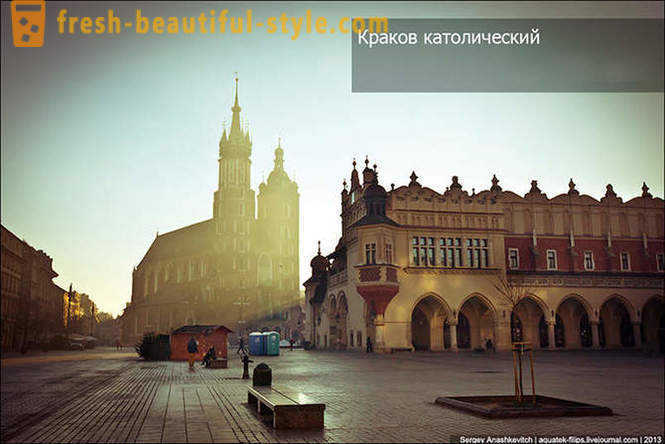
The main shrine of the medieval Krakow - St. Mary's Church.
Modern views of St Mary's is not what it was during the construction of the first Catholic church in this place. The first church was built here, it was made of wood. Later in its place a new Romanesque church was made in the years 1221-1222, the size of close to today. But it was destroyed during the raid of the Tatars.
Later, the foundation of the church was partially used, when construction began on the new church, already in the Gothic style in 1290. That's why he now stands at an angle to the Market Square - after the old church was built before the introduction of radar plan.
In the XIV-th century the building was rebuilt and acquired the Gothic style. Large tower has a height of 81 meters. In the Middle Ages it was a guard and octagonal ending acquired in 1478; white crown added in 1664-m.
With a high signal tower every morning trumpeter heralds the beginning of the day, and that the city gates opened, and every night he preached on the input signal closure of the city.
From Krakow trumpet player is a legend that goes back to the XIV century. According to legend, trumpeter first noticed the enemy, approached the city walls, and has had time to give a signal of danger. But he was killed by being smitten Tatar arrow pierced his throat. In the memory of the legendary death every hour on the four sides of the world, one by one, it sounds over the town tune, suddenly breaking off. At first, the melody is played on the Wawel side for King (south side), then to the town hall side for the city authorities (in the west), then in the direction of the city gates to the guards, and finally, toward the fire protection (fire department, and today is a few hundred meters near the main post). In 1927, this tune was the call sign of the 1st Program of Polish Radio. It is known that the trumpeter played daily on the tower from 1392 until the second half of the XVIII century. It resumed this tradition, oddly enough, when the German occupation in 1941, while the melody was played 2 times a day - at 12:00 and 19:00.
Today, this signal can be heard every hour. Tourists usually gather "to listen" in the courtyard of the St. Mary's Church
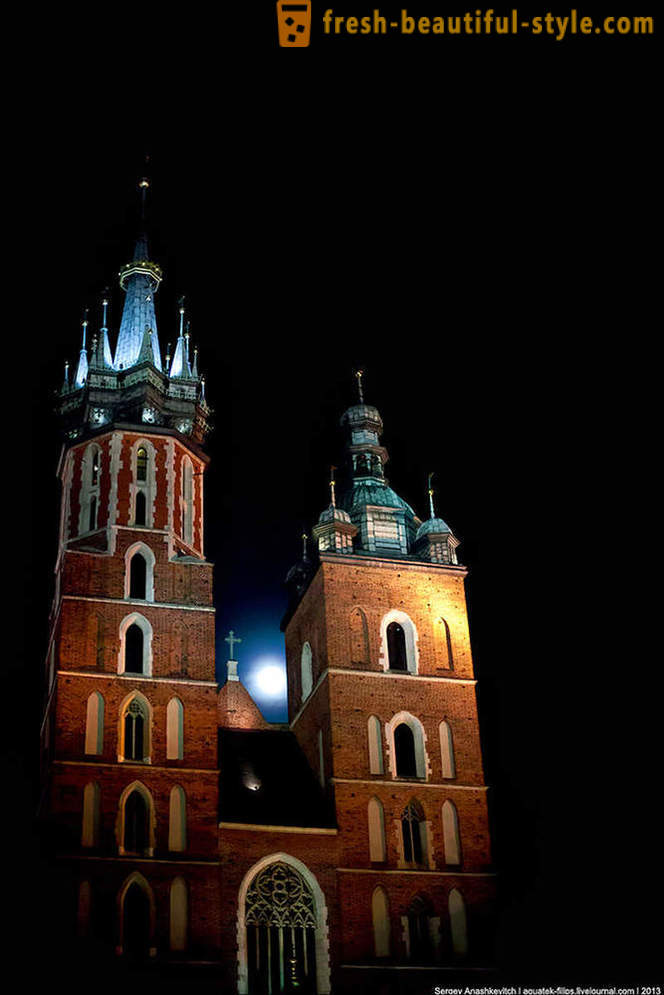
Another one of the best known is Krakow churches church communication. Peter and Paul. Krakow is the first Baroque church.
Previously church belonged to the Jesuits. And the story of its construction is as follows: for the coming of the Jesuits in Krakow began to search for a place to build the church - they did not have enough churches of St. Barbara and St. Schchepana... For reasons of promotion of their monastic order church was located in a historic place, and his appearance greatly stand out from the surrounding buildings. There have been several projects - and on the street Vischlna and Market Square, while in 1596 the construction did not take into their own hands by Cardinal Jerzy Radziwill. Under the influence of Court treasurer of priest Peter Skarga, he took part in the construction and King Zygmunt III. author of the project, approved in Rome, was the chief architect of the Jesuits Giovanni de Rosis.
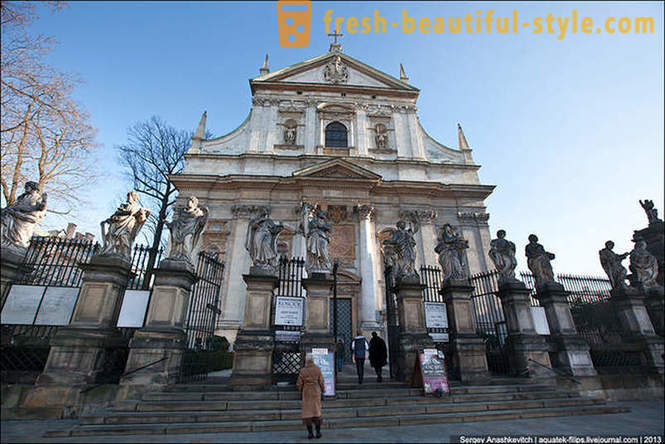
The Church is not quite the usual way - he pushed inland from the street. This was done in order to extend it easier for people to see it not lifting up his head, and that the church was not lost on the background of the surrounding buildings.
He built the church for a long time. With 1597 on 1599 the foundation and walls erects architect Józef Britius that in 1599 to urgently go to Italy. Jan Maria continues to work Bernadoni, which strengthens the walls, because at that time in some places have begun to appear cracks. But in 1605 he died, and up to 1619 job continues Giovanni Battista Trevano. The last phase of work led by architect Matteo Gastello. In 1619, the dome is constructed in 1622-1630 drawn up front, and from 1619 to 1633 held interior. Finally, in 1635, Bishop Tomas church illuminates Oborskiy. Above the main portal we see the coat of arms of the Jesuits, and even higher - the coat of arms of King Zygmunt III.
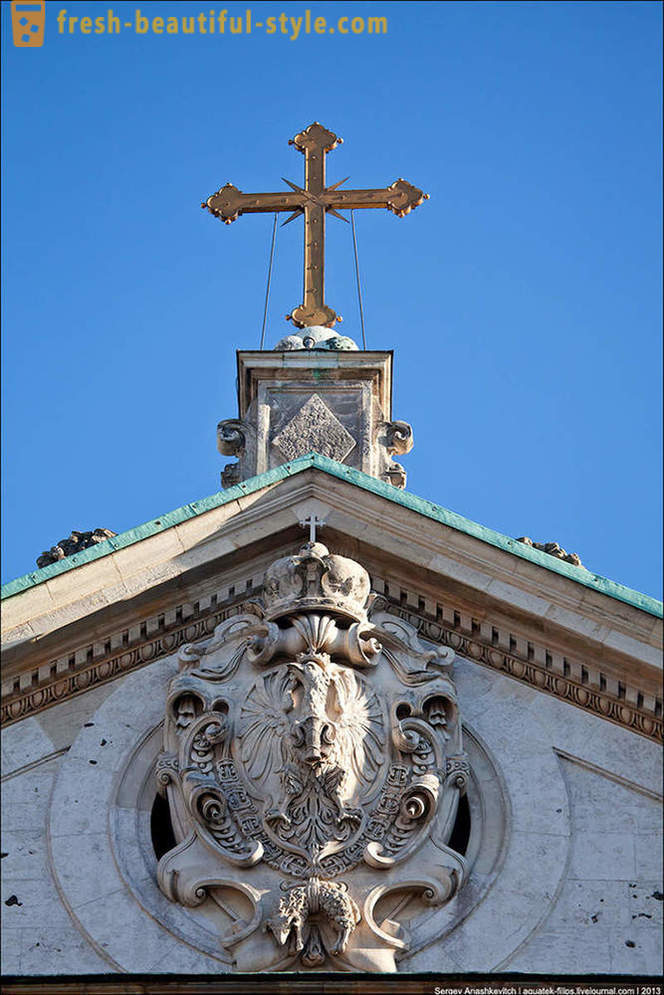
The figures in the niches on the facade - a holy figure. About the church and figures, Cracow joke - the church is so small that even the sculpture had to put on the street. In fact, the sculpture of the 12 apostles, the sculptor David Heel, were delivered here in 1715-1722 by the architect Kacper Bazhankoy.
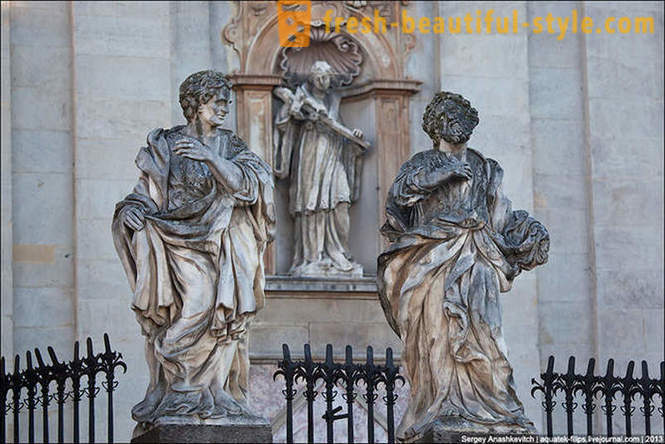
Now the church belongs to the Jagiellonian University, Collegium Iuridicum which is located across the street.
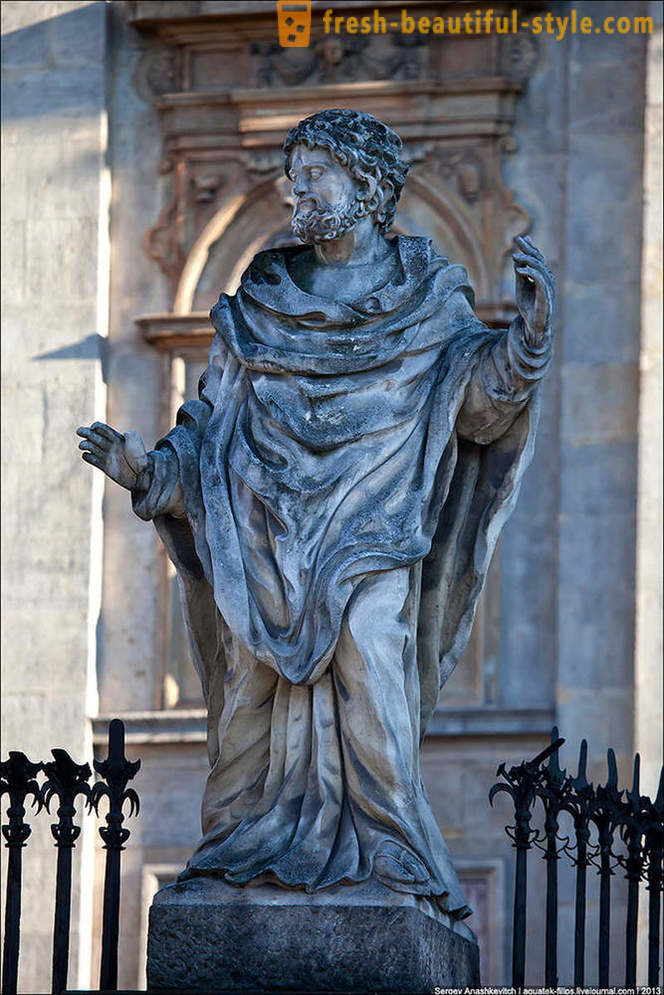
The internal architecture quite severe and monumental. There is something to see.
On weekdays, when there are no services, for visiting the open crypt of priest Peter Skarga. Sculpture of Peter Skarga is located on the right side of the central gallery.
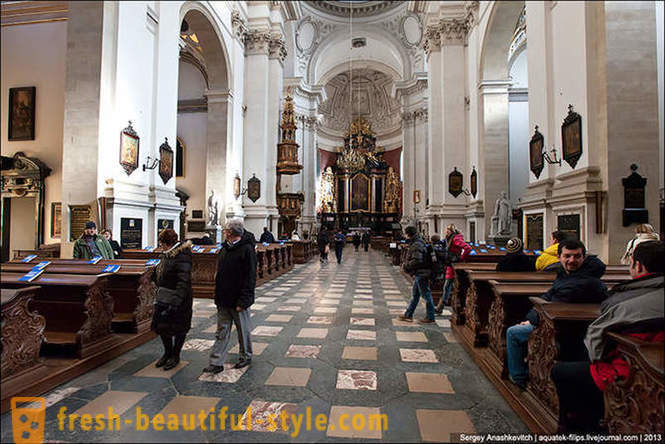
The decoration of the ceiling niches and galleries.
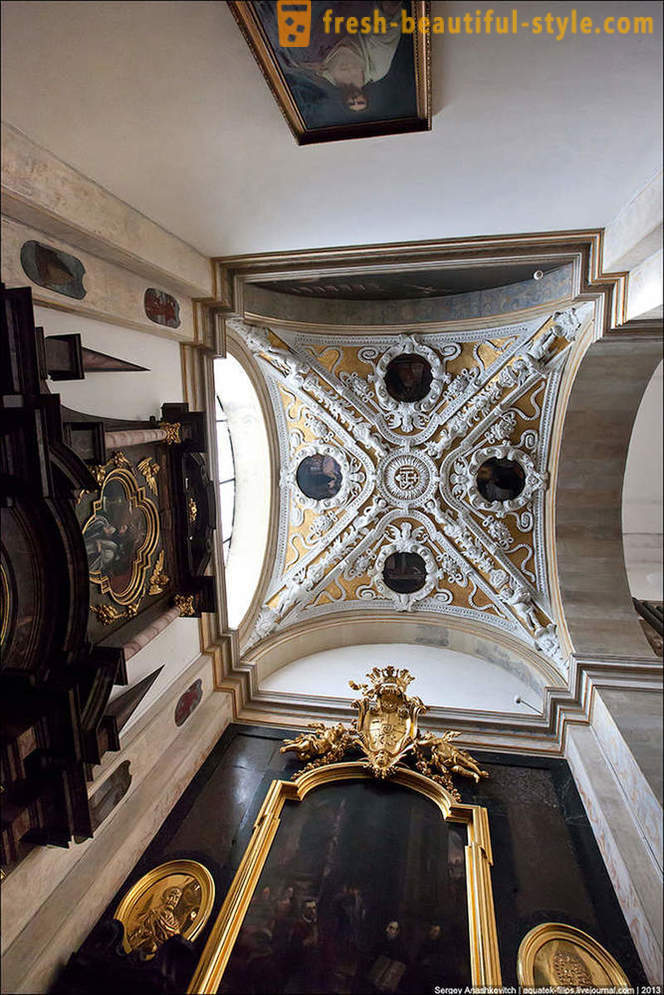
The main church altar

On the left of the altar is the tombstone of Bishop Andrzej Tzhebitskogo

The coat of arms above the main altar
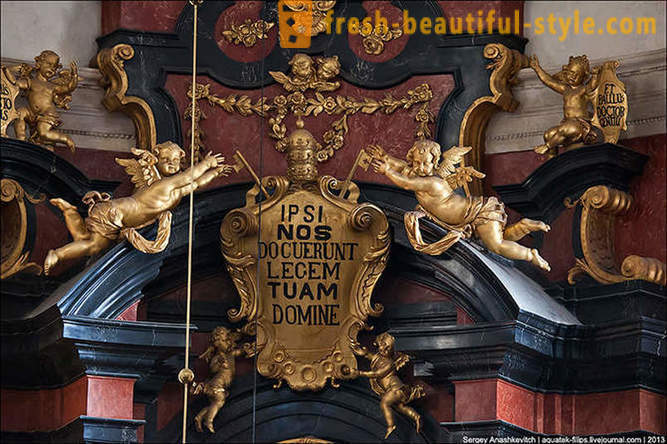
The entrance to the church placed a beautiful organ music and choirs.
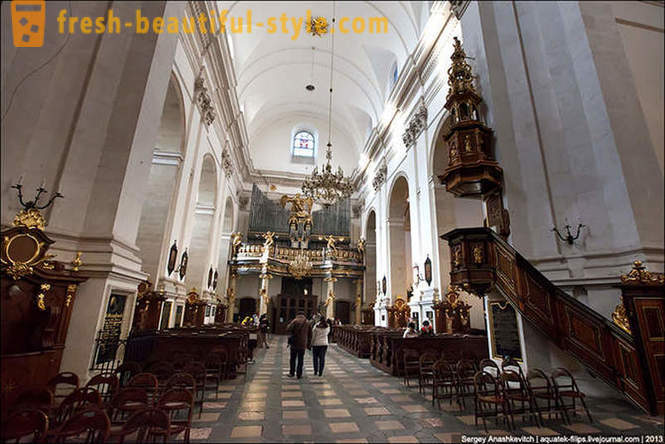
Prayer on benches
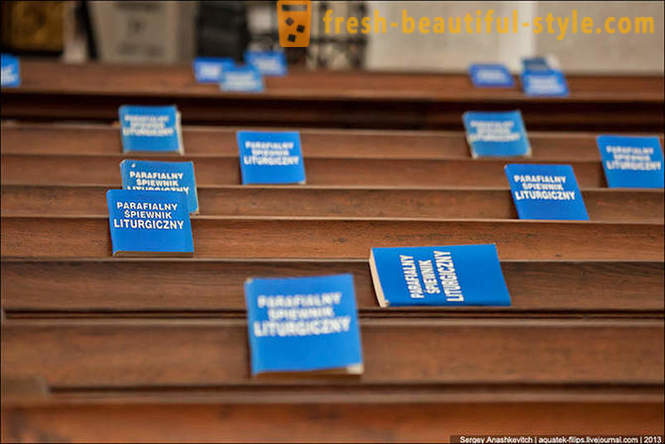
The Poles are considered one of the most religious nations.
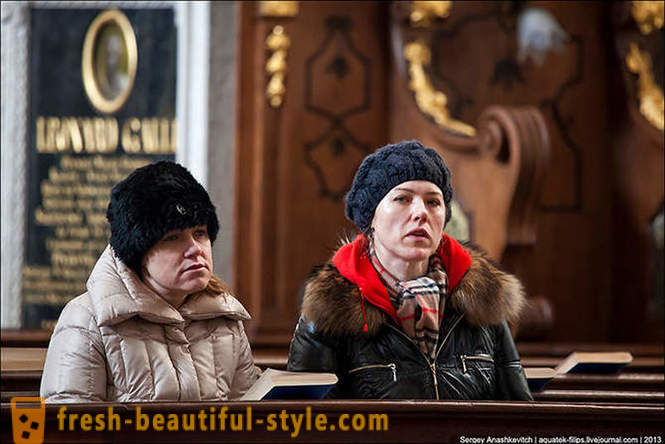
One of the side of the church galleries
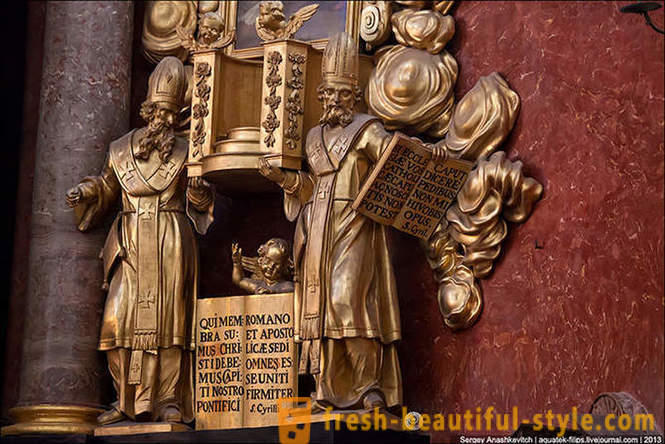
Gilded figurine Legionnaire guards the shrine church.
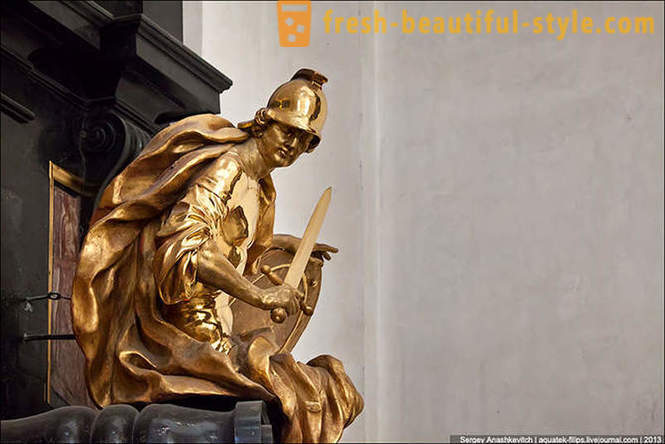
The sculpture, depicting Pope John Paul II appeared in the Church of St. Peter and Paul in 1999.

stucco dome above the main altar

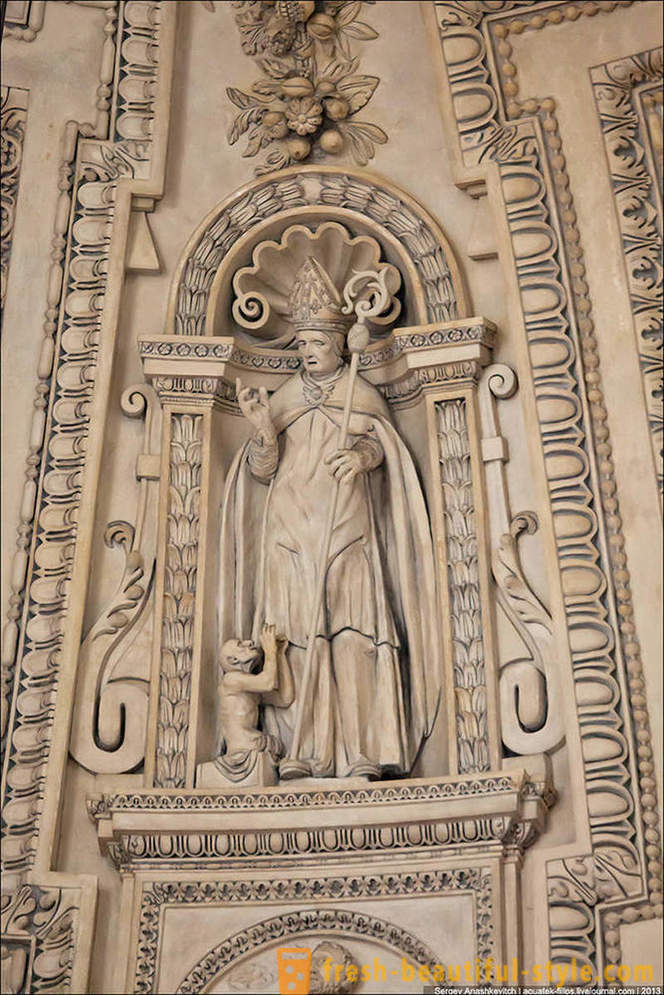
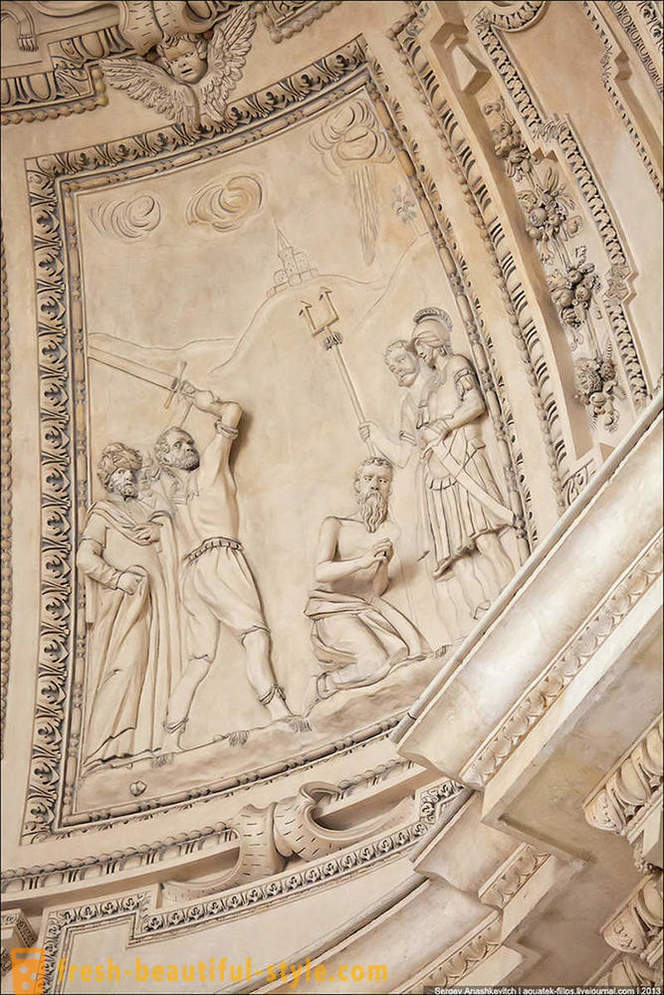
To the right of the church communication. Peter and Church St. Paul located. Andrzej. This is one of the oldest churches in Krakow, which was built in 1079-1098 years voivod Cemex. Just a half-century after its construction, during a routine raid of the Tatars, it sheltered the local people.
At the beginning of the XIII century church rebuilt, and in 1316 he begins to treat Clares convent, which previously was on the pin, and the shrine of the church were transferred to the church of St. Idzi, at the foot of Wawel. Today the monastery Clares (white wall facing the street Galway City - it is just walls of the monastery) is one of the most closed. Its nuns never leave the monastery walls.

Stucco decorating the church, has been added to Balthasar Fontana at the beginning of the XVIII century. And at the same time the interior was painted decorated with motifs lives Blessed Salome. By the size of the church can be seen on the sacred architecture in the heyday of the Romanesque style.
The latter refers to the internal restructuring of 1700, and the last major reconstruction of the church took place in 1947-1950. In the treasury of the church are priceless relics of the XIII century.
Inside the church is quite small. From the altar area it is separated iron bars
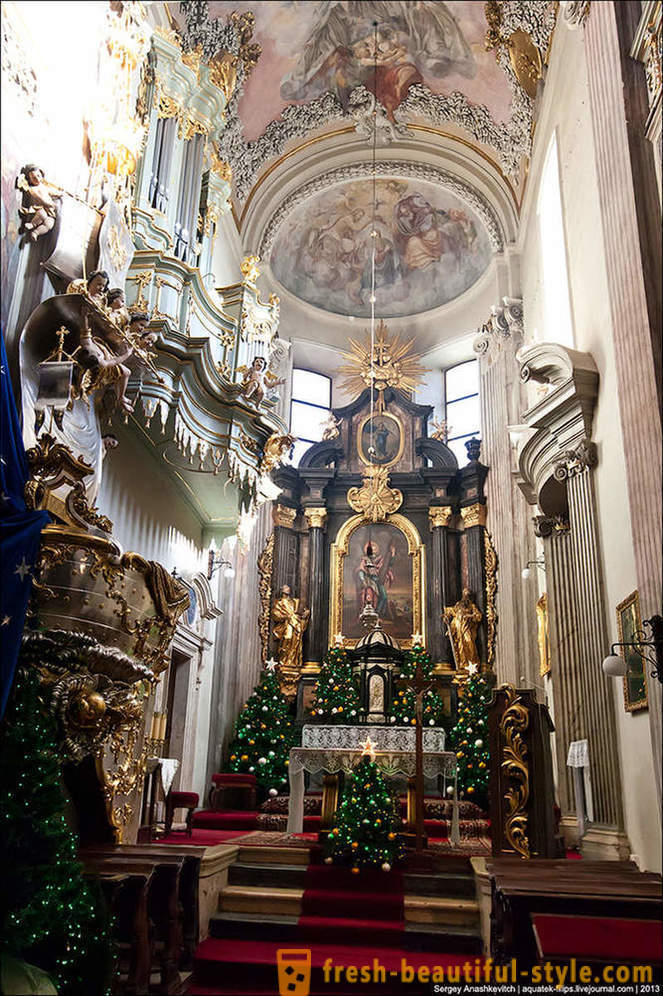
The gate of the church communication. Andrzej outside Galway City.
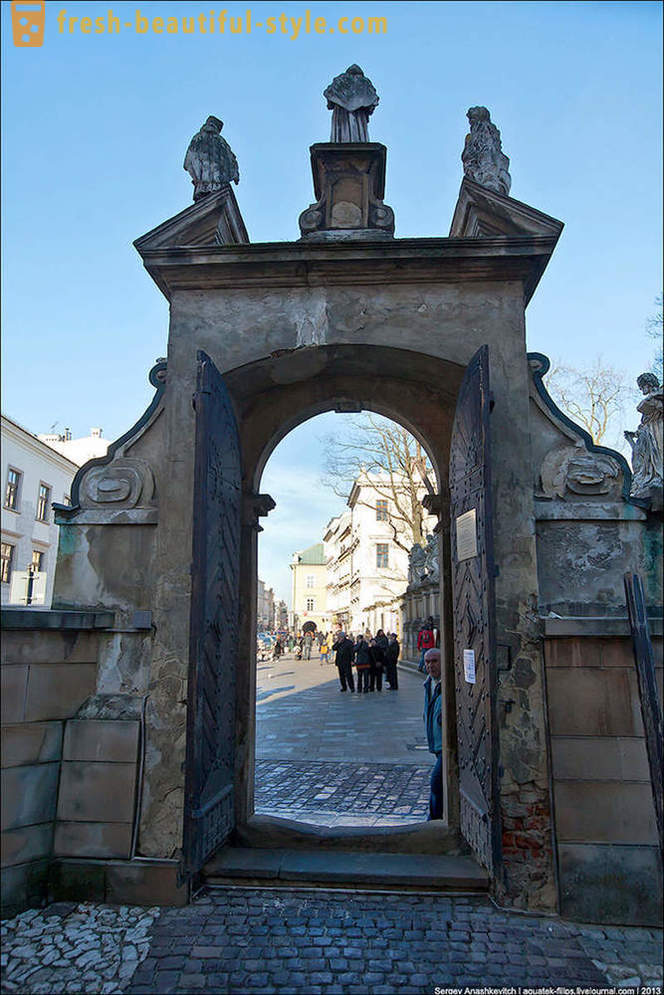
On a small hill, on the bank of the Vistula is the Pauline church. The current church building was built in 1751 by architect Antonio Myunttserom and Antonio Solari. The underground church is the National Pantheon. In it are buried such luminaries as artists Stanislaw Wyspianski, Henry Semiradsky and Jacek Malczewski, poet Theophile Lenartovich and Adam Asnyk writer Jozef Kraszewski and the famous chronicler Jan Dlugosz.

But even before the construction of the modern building there was a church built in the XI century, which in 1079 witnessed one of the most famous and mysterious murders in the history of Poland.
Legend has it that the Polish King Boleslaw the Bold doomed the Krakow Bishop Stanislaw of Schchepanova on the death penalty: during a quarrel the king simply cut off the bishop's head with a sword. Then the body was taken out on the street and cut to pieces.
The remains of the martyrs were thrown into a pond near the church; Another legend claims that they were thrown into the Vistula. Whatever it was, he was buried in Skałka, and 10 years later in 1089 the remains moved to Wawel.
Most importantly, according to legend, the body, chipped, again miraculously grown together. In this visible symbol of the fate of the whole of Poland: it shattered on the part of the state to reunite into one. In 1253 Stanislav canonized; and since then, thanks to the symbolic reunion, he is the patron saint of Poland.
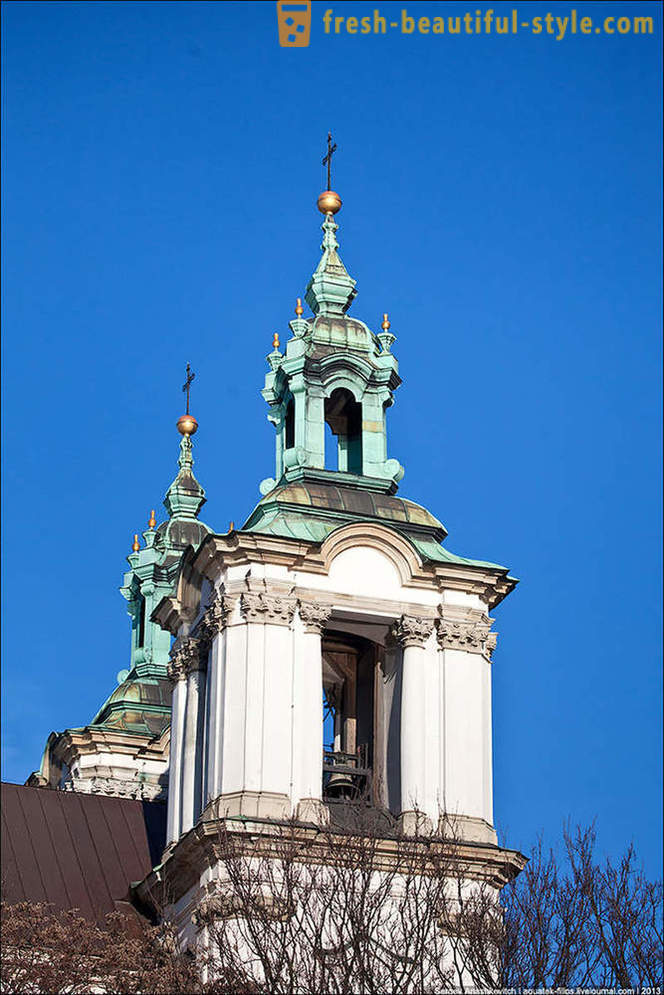
Church of St.. Catherine's Monastery at the Augustinian was zalozhon King Casimir the Great for sin - for the murder of priest Marcin Baryczka in 1349.
Legend has it that who had a hot temper and countless mistresses Casimir so mired in vice, that he mentioned in his sermon, Bishop of Cracow Bodzanta. The king was angry with the bishop, and the unfortunate Baryczka, who gave him the word bishop, ordered to put in a sack and thrown under the ice of the Vistula. The remains of priest then caught ordinary people and buried then in the church of St. Katarzyna.
In fact, the construction began in 1343 and lasted until the beginning of the XVI century.
The monumental main altar created in 1634. Its main decoration is a picture of "The Mystic Marriage of St. Catherine's" Andrzej Vennesta artist, written in 1674.

The building of the church - one of the most beautiful creations of Gothic architecture.

Unfortunately, when there is no service, the church is closed. Therefore, to enjoy the authority to come here either for the morning or the evening service.
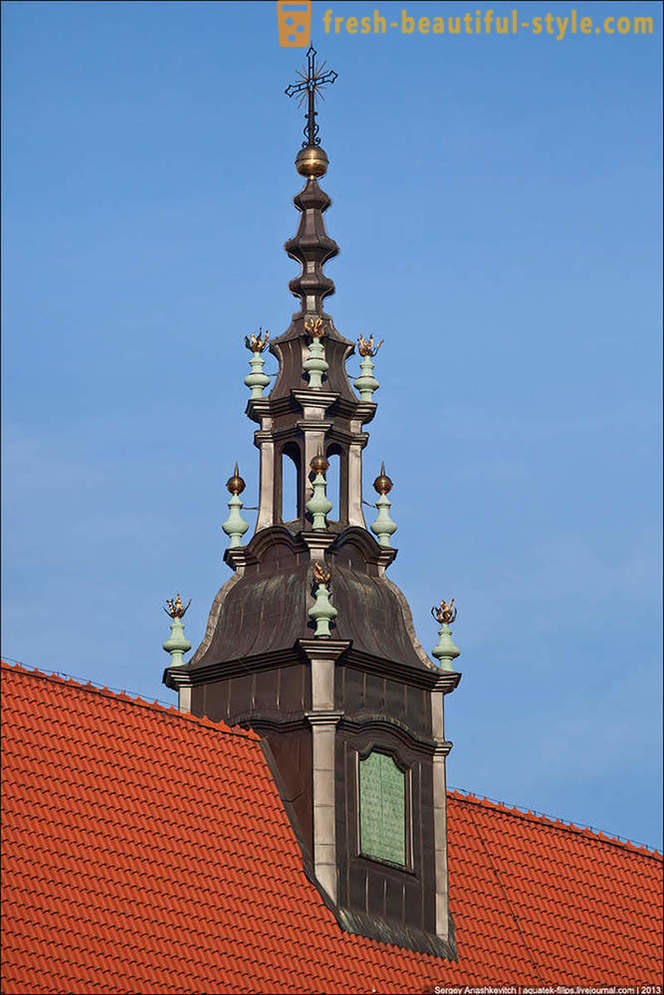
In the area of Kazimierz majestic church Corpus Christi. The founder of the church was the King Casimir the Great. Construction of the church began in 1340 and lasted until the beginning of the XV century.
Church, overlooks the market square - main square - just have to be spectacular. He is really huge and very beautiful inside and it is certainly worth a visit.

As a part of a huge altar, created in the years 1634-1637, is the painting "Adoration of the Magi" Tomasso Dolabella, court painter of King Zygmunt III.
In addition, the church is decorated with large paintings of the artist Lukas Porebskogo. On either side are carved benches of the XVII century.
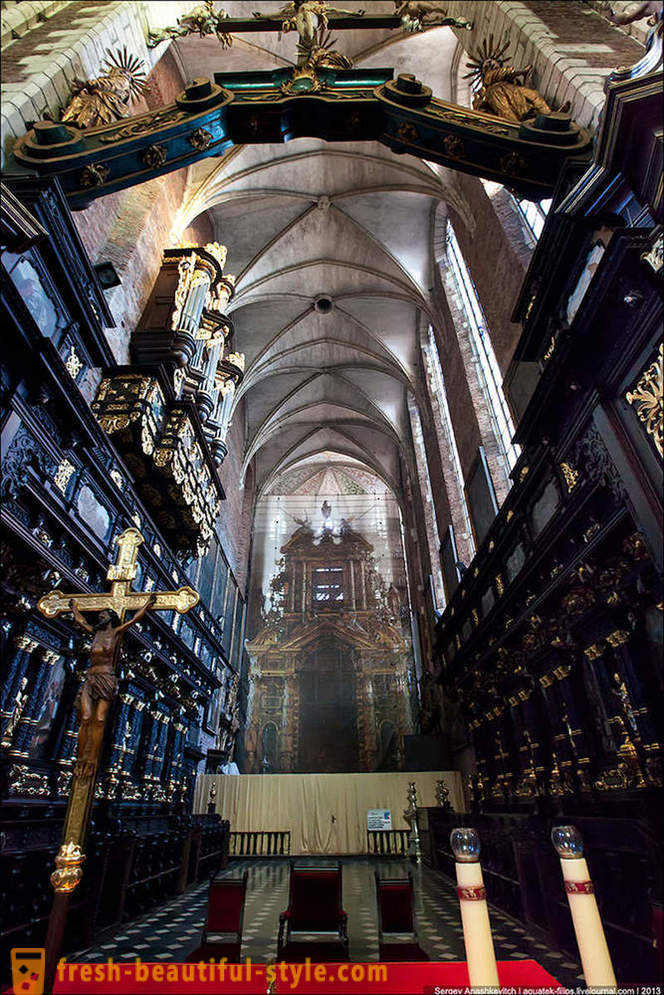
In addition to the carved stalls in the church a huge number of incredibly beautiful carved elements of solid wood
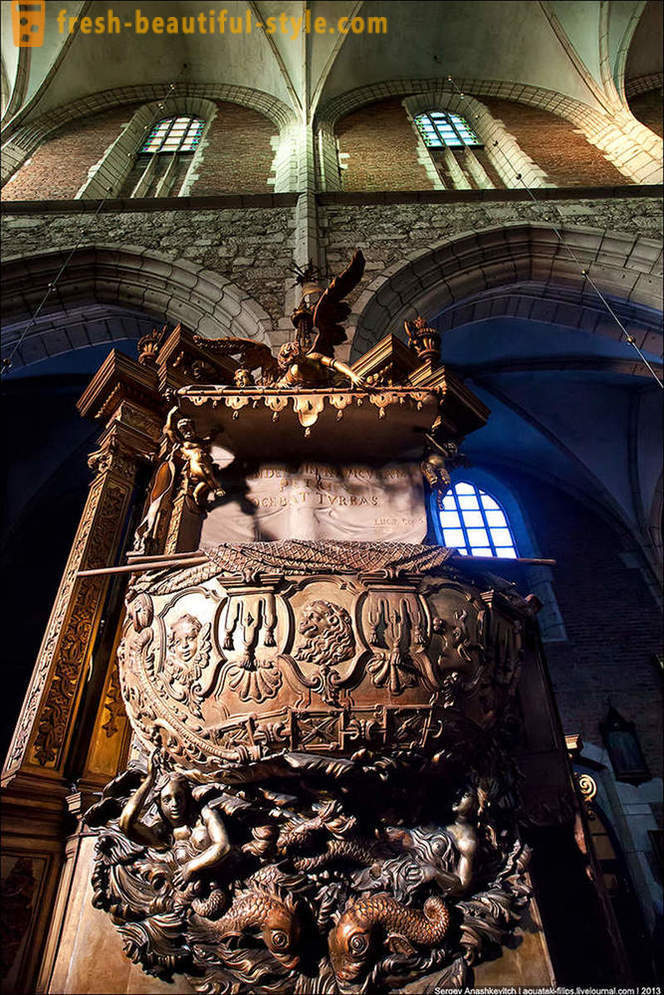
The organ and choir music on in the course to the church

In the northern part of the church there is a stone altar of the XVII century with the relics of Bl. Stanislav Kazimirchik.
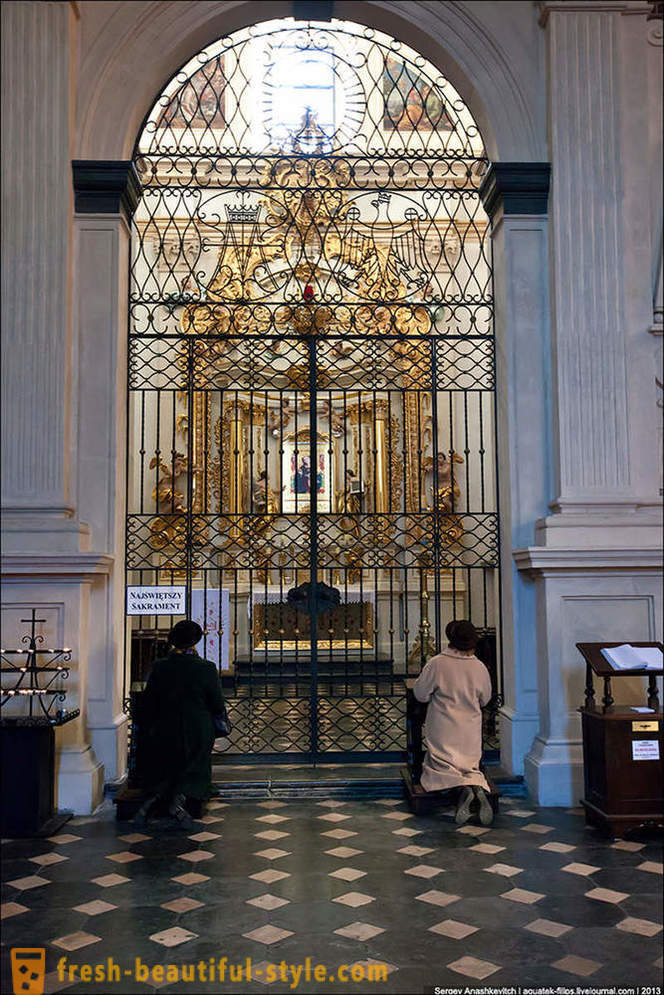
The monumental Gothic cathedral of St. Josef is located in Podgorze district of Krakow.
The main tower of the church is quite low in relation to other parts were such are the Austrian rules prohibiting the construction of tall buildings in urban areas, performing the role of the military outposts.
Towers resemble St. Mary's Church - it tried architect Jan Sas Zubzhitsky, who wanted to introduce the term "nadvislyanskaya Gothic", representing its own vision of the folk style.

Catholic church of St. Anne, located in Krakow's Planty, is considered a university. Here at the beginning of the school year are a joint service of professors and top students. It should be noted that any academic year, in schools and in institutions in Krakow, begins with worship. By the way, most of the time the church is closed.
It was built by the decision of the Academy leadership. Construction began in 1689 under the direction of Sebastian Piskorski, and interior decoration was carried out in 1695-1703 by the architect Balthasar Fontana.
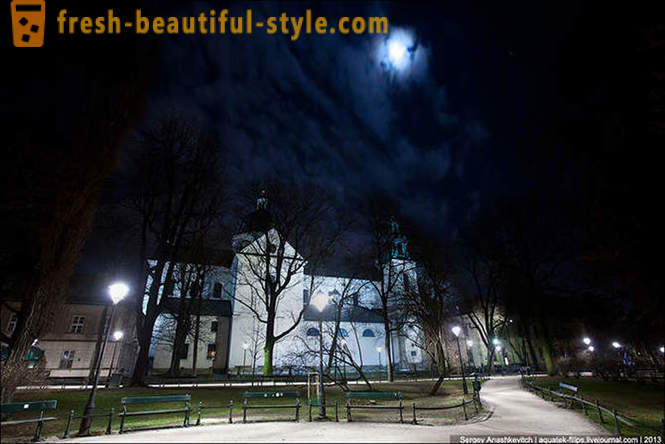
Church communication. Florian, built in the XIV century, and formerly belonged to the Jagiellonian University. The building, which is situated now, was built in the XIV century, and the first church on the site was made back in 1185. With its associated tab ancient legend. So, in those years, each city would like to have the relics of saints, because we believe that the more relics, the city will be more devout, and therefore more respected. Pope Lucius III at the request of King Casimir the Just send him a body of the martyr Florian. The holy relics went out to meet all the pious, Cracow, headed by King Casimir the Just, and the bishop of Cracow Gedeon. Suddenly, on the way to the city, oxen, wagon vozshie relics, stood up, and no power could not budge them. It was only when the King and the bishop promised to put in the place of a church, the carriage moved on. And so it came to this place church. . The cult of St. Florian's in Krakow, had greater strength, for example, is named after him and the tower Florianska - the main entrance to the city, and the street leading to the market square. By the way, in 1945-1951, the vicar of the church was Karol Wojtyla, the penultimate Pope John Paul II.
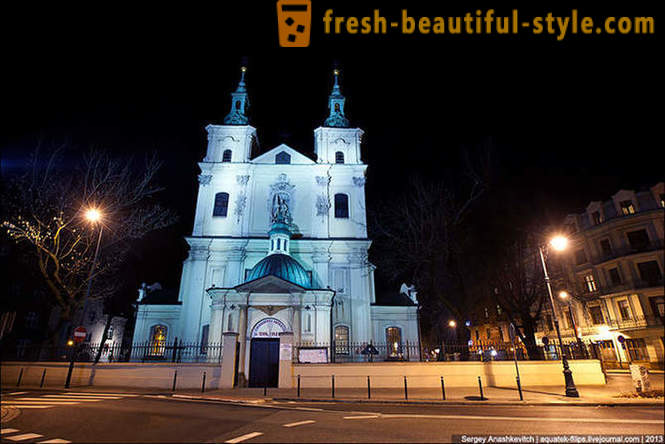
Catholic church of the Holy Trinity, or the Dominican Church XIV-XV century - one of the largest Gothic Basilica Krakow.
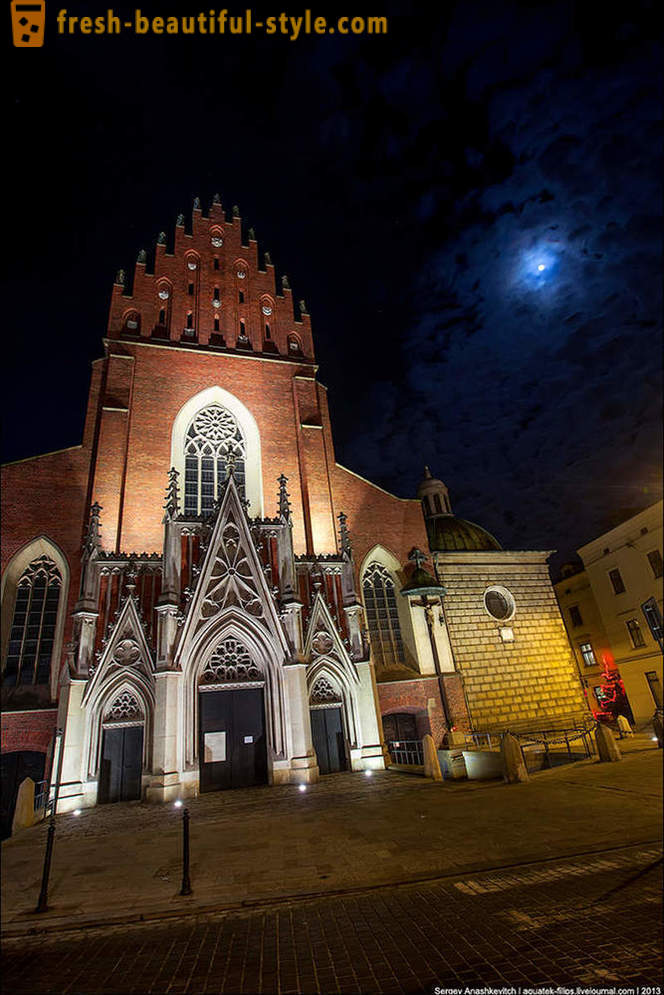
As mentioned in the beginning, almost all of Krakow's churches acting. On ordinary days, the prayers are held in the morning, to about 9-10 hours in the morning and in the evening, usually from 19:00.
The rest of the churches in the central part of the city just opened for tourists, but less well-known at this time closed.
Therefore, if you want to see some kind of a church, which is closed during the day (for example, the Church of St. Bernard at Wawel), come shortly before the prayer or immediately after its completion. Inspect the churches during services generally prohibited, but as in ordinary days they present a few people, you can leisurely explore the church even during the service. Of course, while not interfering with the believers. You can always use the side aisles.
Various types of photo and video shooting in churches usually are not prohibited (unless it is a territory of the museum, while for the right to film have to pay).
So in churches, if at the entrance to the church there is a prohibiting sign, can be removed. If the sign shows a camera with a flash crossed, then you can shoot, but it is forbidden to use flash













































